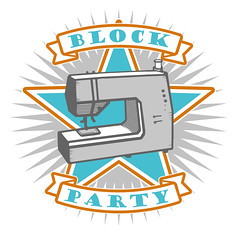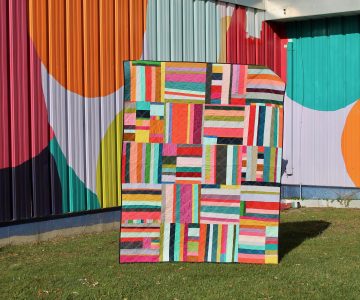
I love seeing fabric around the house, and I love making useful things out of fabric. Luckily these round bottomed storage buckets hit both points! Max seems to be amassing lots of collections of various types of toys these days, and as much as I try to keep them all organized, somehow I’m still always tripping over a matchbox car or lego piece. But I’m hoping that having places to put these toys will lessen the number of times this happens (a girl can hope, right?).

Of course, toys aren’t the only thing you could store here – they’d also be good for knitting supplies, fabric scraps, hats & mittens, um… a pretty covering for a potted plant? Whatever you want!

And of course, since not everyone has use for this small size, I’ve also provided measurements for a larger version, perfect for storing yarn (I have 15 skeins in the one shown above), or anything else you can think of!
Want to make some of your own? Let’s get going!
Materials needed –
[Edited 12/2017 to add measurements for mini size]
For itty bitty bucket:
- 2 pieces of fabric, 13 1/2″ x 6 1/4″
(one outer, one lining)
- 2 pieces of fabric, cut into circles with a 4 1/2″ diameter
(one outer, one lining)
- interfacing for outside fabrics
For small bucket:
- 2 pieces of fabric, 19 1/2″ x 10 1/2″
(one outer, one lining)
- 2 pieces of fabric, cut into circles with a 6 1/2″ diameter
(one outer, one lining)
- 1 piece of interfacing, 19″ x 10″
- 1 piece of interfacing, cut to a circle with a 6″ diameter
For large bucket:
- 2 pieces of fabric, 31 3/4″ x 17″
(one outer, one lining)
- 2 pieces of fabric, cut into circles with a 10 1/2″ diameter
(one outer, one lining)
- 1 piece of interfacing, 31 1/4″ x 16 1/2″
- 1 piece of interfacing, cut to a circle with a 10″ diameter
A few notes:
The small size has a finished base of 6″, with a height of about 10″ (with the top unfolded). If you use a contrasting fabric for the circular base, this is a great project to use up fat quarters!
The large size has a finished base of 10″, with a height of just over 16″, and can be made using a 1/2 yard of fabric for the outside, and 1/2 yard for the lining.
[mini size has a base of about 4″, with a height just under 6″ (unfolded). Mini size can be made from a FE of each outside and lining fabrics]
The links provided in the materials section above are PDFs for the circle template. Feel free to print this out and use it as a template for your circles, or use your own preferred method for drawing a circle with the appropriate diameter. (Please note that the template for the larger size will print on 4 pages and will have to be cut and taped together.)
I recommend a heavyweight fabric for the outside, which will give your bucket more structure – home dec, canvas, a cotton/linen blend would be appropriate. I like to use a quilting weight cotton for the lining.
The interfacing is optional, depending on how sturdy you want your bucket to be. For the small buckets shown in the photo above, I used a heavyweight canvas fabric for the outside, and felt it was heavy enough to forgo the interfacing. For the bucket shown in the tutorial photos, I used a heavier fusible interfacing to give the linen/cotton blend outer fabric a bit more structure.

Cut your fabrics to size, and, if using interfacing, follow manufacturer’s instructions to fuse the interfacing to the wrong side of your outer fabrics.

Sew the short sides of your main outer fabric together, right sides together and iron seam open. Iron crease marks at the base of your main fabric, first in half and then in quarters. Do the same with your circle, folding it in half and then in quarters, and iron so you’ll have markings.

Using these markings, match up the markings on the base with the markings on your main fabric and pin at these points. Then ease in the fabric between each marking and pin.

Sew the base to your main fabric. I like to sew with the base on top, sewing slowly and using the needle down feature.

Once you’ve sewn the base, flip your bucket right side out, and repeat the above steps to sew the lining.

Leave the lining inside out, and slip the outer bucket piece into the lining piece (the right sides of your fabrics will be facing). Align the top edge and pin along the perimeter. Sew along this edge, leaving a space about 3-4″ long open for turning. Pull your bag through this opening and fit the lining into the main bag. Iron this top edge, tucking the open edge down. Topstitch along this edge, closing the opening at the same time.

Fold down the top edge so you get a peek at the lining and fill with whatever you’d like!

Our small buckets are already filled with a variety of toys

and the large with my stash of yarn (maybe seeing it out will encourage me to knit!)



















 Greater than/less than
Greater than/less than scrappy solids
scrappy solids